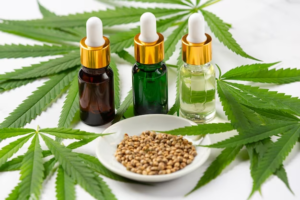
For mothers, whether they are first-time expectants or experienced with multiple children, it remains a pressing concern how any ingested substances can influence an unborn baby or an infant consuming breast milk.
Similar to substances like tobacco, cannabis, alcohol, and street drugs, careful consideration is warranted even when these are consumed in minimal amounts, due to the potential implications they might have on fetal and early child growth.
With the legalization of CBD products stemming from the 2018 Agriculture Improvement Act, the scientific community has yet to amass a substantial number of studies that pinpoint any detrimental links between breastfeeding mothers consuming CBD and potential risks to their breastfed infants.
By leveraging the scant research available and drawing insights from studies centered on maternal marijuana consumption during pregnancy, spearheaded by renowned American research institutions, it becomes feasible to sketch a science-based depiction of the implications of cannabis-derived product intake on both neonatal and child health.
Deciphering the Science: Cannabidiol Explored
CBD, or Cannabidiol, is a predominant psychoactive component within the cannabis plant. Though less potent compared to tetrahydrocannabinol (THC) – the primary psychoactive component in cannabis – CBD doesn’t induce the pronounced mind-altering effects synonymous with THC.
Nevertheless, CBD is an active compound with an array of associated benefits upon regular consumption. This suggests potential long-term repercussions on infants who consume breast milk, particularly when considering CBD in its pure, isolated form.
Greater caution is urged when it comes to broad-spectrum CBD products derived from cannabis. These products not only comprise CBD and nominal THC levels but also encapsulate hundreds of other potential compounds intrinsic to the hemp plant.
Diverse Properties: The Cannabis Plant’s CBD Component
The limited research on these auxiliary cannabinoid compounds makes it challenging to ascertain any possible threats to breastfed infants. Employing broad-spectrum CBD during breastfeeding is a significant decision, given the myriad of cannabinoids and the accompanying uncertainties due to the paucity of scientific knowledge.
One of the pivotal aspects when discussing marijuana consumption during pregnancy and nursing is the fact that its compounds metabolize through fat molecules, deviating from most substances that utilize water molecules.
The Dynamics: Fat Soluble vs. Water Soluble Compounds
Generally, prescribed drugs can be categorized as water-soluble, implying they are metabolized via water molecules in the body. This results in the substances’ residuals lingering in the body for approximately 3–5 days before being expelled through natural processes like perspiration or urination.
On the other hand, fat-soluble entities like CBD oil undergo metabolism within fatty tissues, leading to prolonged retention within the body. These compounds don’t undergo standard elimination processes. Instead, they accumulate within adipose cells, gradually metabolizing as these cells process with food molecules in the liver.
The Correlation: Fat-Tissue Solubles and Breast Milk Composition
Given that breast milk predominantly contains fat-based nutrients, there is an elevated likelihood of infants being exposed to CBD and other cannabis compounds post maternal consumption. This exposure risk heightens with increased frequency of maternal CBD usage. Unlike alcohol, where mothers can ‘pump and dump’ the milk to eliminate toxins, no established methods can cleanse breast milk of cannabinoids currently.
Duration of Retention: CBD in the Human Body
Breast milk analysis indicates detectable CBD levels for up to six days post-consumption. However, the detection window varies based on factors such as frequency, dosage, and concentration, among others. Consistent, heavy cannabis users might have traces in their bloodstream for weeks.
Reasons for CBD Consumption Among Nursing Mothers
Potential benefits that may entice mothers include:
- Chronic pain relief
- Stress alleviation
- Muscle pain relief
- Sleep aid
- Hair, skin, and nail health
Safety Concerns: CBD and Newborns
High tetrahydrocannabinol (THC) concentrations in newborns have been linked to adverse effects. Similarly, newborns might ingest harmful chemicals through breast milk due to the consumption of substandard CBD products, exposing them to contaminants more detrimental than typical cannabis elements.
Potential Infant Risks: CBD Exposure in Breast Milk
Until comprehensive research surfaces, relying on available evidence is prudent. Given the endocannabinoid system’s crucial functions in motor coordination, and immune system functionality, among others, persistent excessive exposure might lead to cognitive impairments, motor function issues, and weakened immune defenses in newborns.
Safe CBD Consumption During Breastfeeding?
As of 2022, no method guarantees preventing CBD from full-spectrum products from infiltrating breast milk. However, mothers needing CBD can:
- Align CBD intake with breast milk pumping and testing for CBD after detoxing.
- Use baby formula as a breast milk substitute.
A Comparative Look: CBD vs. Other Common Substances in Breastmilk
To truly appreciate the potential implications of CBD in breastmilk, it’s pivotal to understand how it compares to other frequently consumed substances by nursing mothers.
Comparative Table: CBD and Other Common Substances in Breastmilk
| Substance | Detection Period in Breastmilk | Known Impacts on Infant | Mitigation Techniques |
| CBD | Up to 6 days | Potential cognitive impairments, motor function issues | Pump and test; consider formula as an alternative |
| Alcohol | 2-3 hours per drink | Decreased motor development, changes in sleep patterns | Pump and dump; time consumption around nursing schedules |
| Nicotine | 95 minutes – 2.5 hours | Colic, respiratory issues, sleep disturbances | Consider nicotine patches; delay breastfeeding post-smoking |
| Caffeine | Varies, peak at 2 hours | Irritability, sleep disturbances | Limit intake; time consumption around nursing schedules |
| Medication | Varies widely | Varies by medication; some can cause drowsiness or gastrointestinal disturbances | Consult with healthcare provider; consider alternative medications or timing |
Understanding CBD’s Increasing Popularity among Nursing Mothers
In recent years, CBD’s surge in popularity can be attributed to its touted benefits. Advocates praise its potential to alleviate various ailments without causing the “high” associated with marijuana. From reducing anxiety and managing pain to improving sleep, CBD products have been hailed as a natural remedy.
This allure isn’t lost on nursing mothers. Many face postpartum depression, anxiety, and physical pains that can be intense and pervasive. For a mom who might be wary of pharmaceutical solutions, especially while nursing, CBD seems a tempting proposition. Furthermore, anecdotal evidence suggests that some mothers believe that CBD helps improve milk production. However, it’s essential to stress that this claim remains scientifically unverified and can lead to potential misinformation.
The Regulatory Landscape: How Governments are Responding
Governments globally are grappling with CBD’s legalization and its implications for specific vulnerable populations, like nursing mothers. While some nations outright prohibit CBD, others have lax regulations or fall somewhere in between.
In the U.S., the Food and Drug Administration (FDA) currently advises against CBD use during pregnancy or while breastfeeding. Other countries, like Canada and parts of Europe, have also issued similar cautions. One challenge is the inconsistency of CBD products. Without stringent regulation, mothers might be consuming products with varying CBD levels, and in some cases, potentially harmful additives.
The Global Perspective on CBD and Breastfeeding
Across the world, the stance on CBD usage varies. In some regions, its use has been legalized for medical or recreational purposes, while in others, it remains strictly prohibited. With its global spread, the question of CBD’s effects on breastfeeding mothers and their infants becomes even more pressing.
The European Union (EU), for instance, has categorized CBD as a novel food, requiring businesses to gain authorization before marketing it. While this doesn’t directly address breastfeeding, it highlights a cautious approach to the compound. In contrast, countries like Canada, where cannabis has been fully legalized, public health advisories caution against the use of CBD or any cannabis product during breastfeeding.
However, regardless of location, a universal sentiment prevails: the health of the child comes first. Until comprehensive research offers conclusive evidence, the uncertainty surrounding CBD’s potential risks makes many health professionals worldwide advise against its use during breastfeeding.
An In-depth Look at the Endocannabinoid System and Infants
Our bodies have an endocannabinoid system (ECS) that interacts with both endocannabinoids (produced naturally) and phytocannabinoids (like CBD). This system is involved in numerous physiological processes, including mood, appetite, and pain sensation.
Interestingly, the ECS plays a crucial role in the early stages of life. For instance, endocannabinoids are believed to trigger milk sucking by newborns, an essential reflex for survival. This intricate involvement of the ECS in neonatal development is one reason why many scientists express concerns about introducing external cannabinoids, like CBD, during this delicate phase.
When a breastfeeding mother consumes CBD, it’s not just the infant’s immediate response that’s a concern, but also the long-term implications. With the ECS playing roles in brain development and function, introducing phytocannabinoids might disrupt its natural processes, potentially leading to developmental issues.
A Closer Examination of Full-Spectrum, Broad-Spectrum, and CBD Isolate
For those exploring CBD products, understanding the distinction between full-spectrum, broad-spectrum, and CBD isolate is crucial. These terms reflect the composition of cannabinoids and other compounds in the product.
- Full-spectrum CBD: Contains all the natural compounds found in the cannabis plant, including THC (though usually in minimal amounts below 0.3%). This composition is believed to create an “entourage effect,” where the combined compounds work synergistically.
- Broad-spectrum CBD: Similar to full-spectrum but with THC entirely removed. This form is preferred by those who want the benefits of multiple cannabinoids without the potential effects of THC.
- CBD Isolate: The purest form, containing 99% CBD and no other cannabinoids.
For breastfeeding mothers, understanding these differences is pivotal. While some argue that the minimal THC in full-spectrum products is negligible, its presence in breast milk and potential effects on the infant remains a concern.
When considering any CBD product, it’s crucial to verify its source, potency, and purity. Ensure third-party labs have tested the product, and always consult with a healthcare professional.

The Influence of Societal Perceptions and Marketing on CBD Consumption
The modern world finds itself in the middle of a CBD revolution. From oils, creams, and edibles to its use in wellness and spa treatments, the ubiquity of CBD products is undeniable. As with any trend, societal perceptions play a significant role in driving its popularity, and CBD is no exception.
One of the primary motivators behind the CBD surge is the narrative of it being a ‘natural remedy.’ People are often drawn to what is perceived as organic or natural, believing it to be inherently safer or more beneficial than synthetic alternatives. While CBD does indeed derive from the hemp plant, it’s essential to remember that ‘natural’ doesn’t always equate to ‘safe,’ especially when considering the potential unknowns surrounding CBD and breastfeeding.
Moreover, the marketing strategies employed by many CBD companies further amplify these beliefs. Through persuasive advertisements and testimonials, they present CBD as a panacea, capable of alleviating various ailments from chronic pain to anxiety. This omnipresent marketing influences societal perceptions, making the compound seem more benign than it might actually be for specific populations, such as breastfeeding mothers.
Furthermore, the role of celebrities and influencers in endorsing CBD products can’t be understated. Their widespread reach and influence can shape the decisions and perceptions of millions. When a well-known personality endorses a CBD product or shares their positive experiences, it inadvertently lends credibility to its safety and effectiveness.
However, it’s imperative for consumers, especially vulnerable groups like breastfeeding mothers, to approach these endorsements and advertisements with a degree of skepticism. While CBD may offer numerous benefits for the general population, its effects on nursing mothers and their infants remain under-researched.
Conclusion
The rapidly evolving landscape of CBD research and its widespread consumption presents both opportunities and challenges. While its therapeutic benefits hold promise, the potential risks, particularly for breastfeeding mothers and their infants, cannot be overlooked. Our comprehensive exploration underscores the importance of informed decisions. Nursing mothers must remain abreast of ongoing research and, above all, prioritize the well-being of their newborns. In the realm of CBD and breastfeeding, it’s paramount to tread with caution, leaning on credible scientific evidence and professional guidance.
FAQ
1. Can CBD pass into breast milk?
Yes, CBD can pass into breast milk. Like many other substances, CBD that is consumed by a breastfeeding mother can find its way into her milk. The exact concentration and effects on the infant are still being researched.
2. Is it safe to use CBD oil while breastfeeding?
The research on CBD and breastfeeding is still emerging, and conclusive evidence is lacking. Many health organizations, including the FDA, advise against using CBD while breastfeeding because of potential risks to the infant.
3. Can CBD affect milk production?
Anecdotal reports suggest that some mothers believe CBD helps with milk production. However, there’s no concrete scientific evidence supporting this claim. It’s essential to approach such beliefs with skepticism and consult with a healthcare provider.
4. What are the potential side effects of CBD on infants?
Potential side effects, based on preliminary studies, include cognitive impairments and issues with motor function. However, the exact long-term effects remain unknown.
5. Are there alternatives to CBD for managing postpartum symptoms?
Absolutely. Mothers facing postpartum depression, anxiety, or pain should consult with healthcare professionals. There are many safe and tested treatments, therapies, and medications available to help manage postpartum symptoms.





